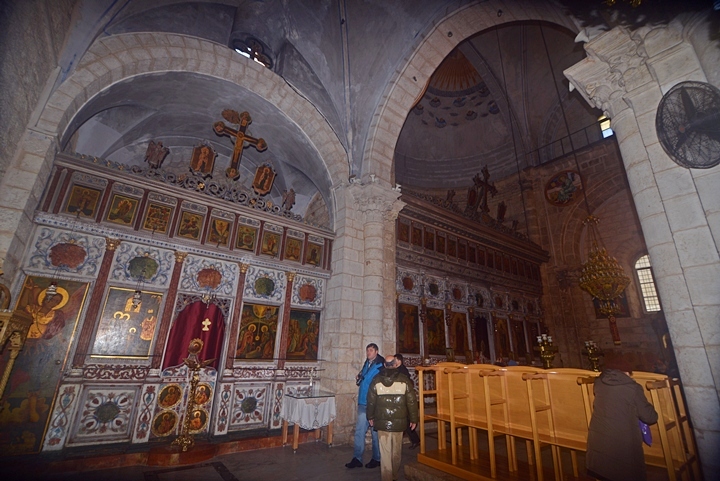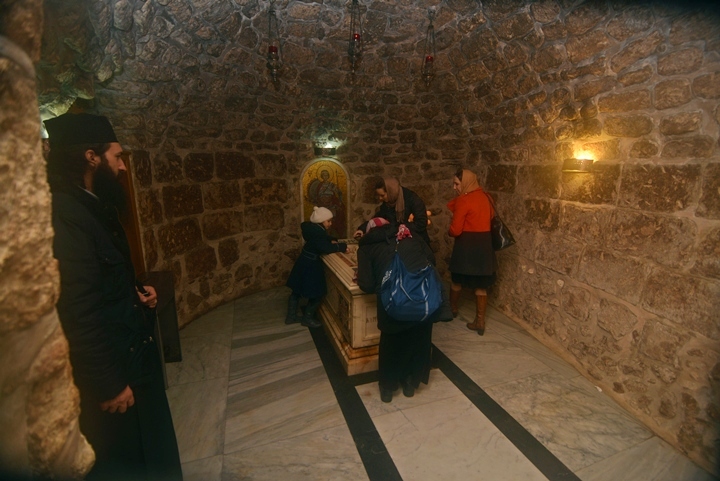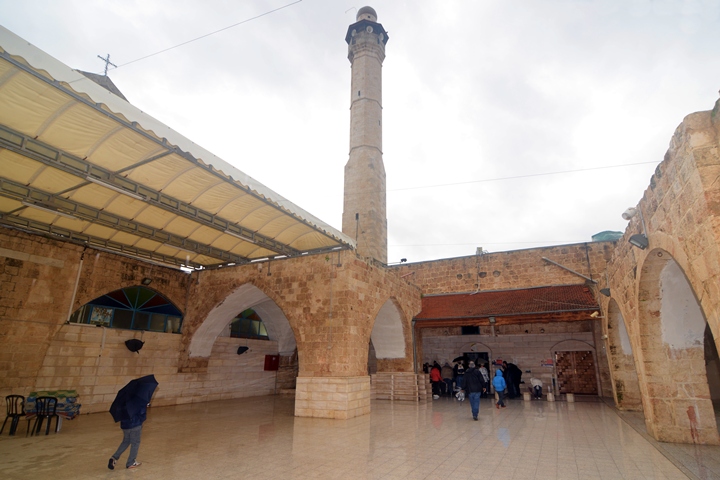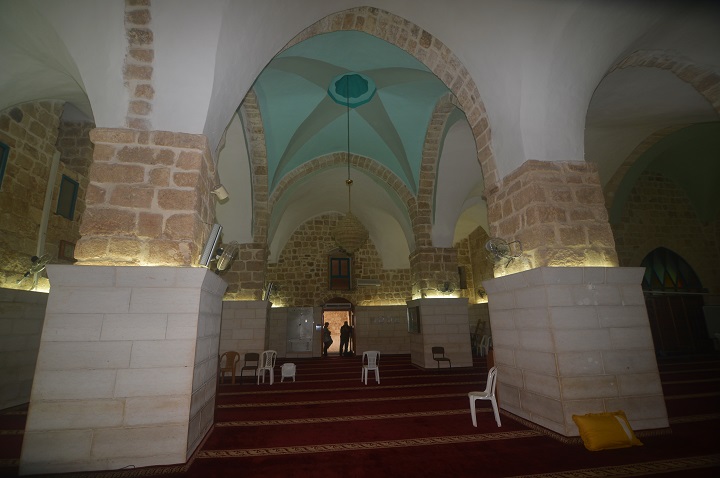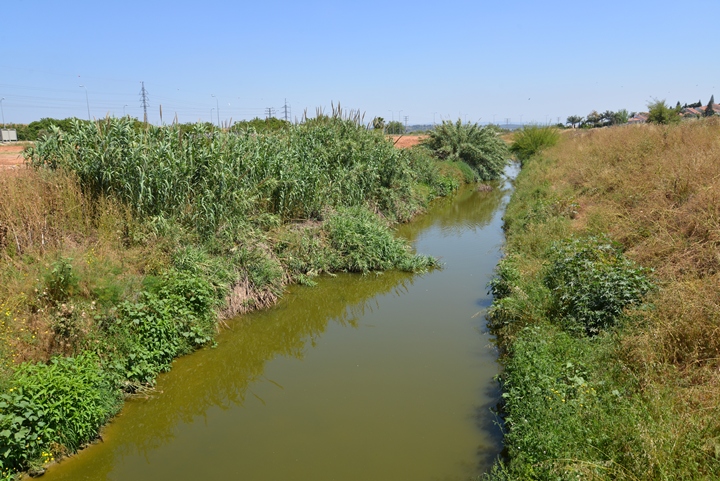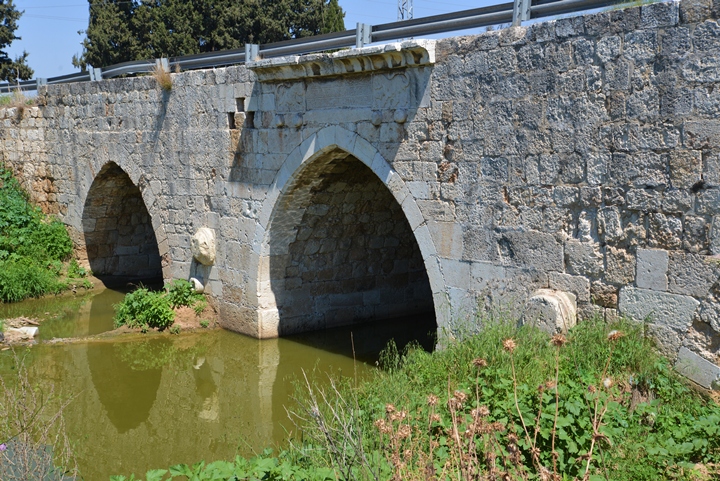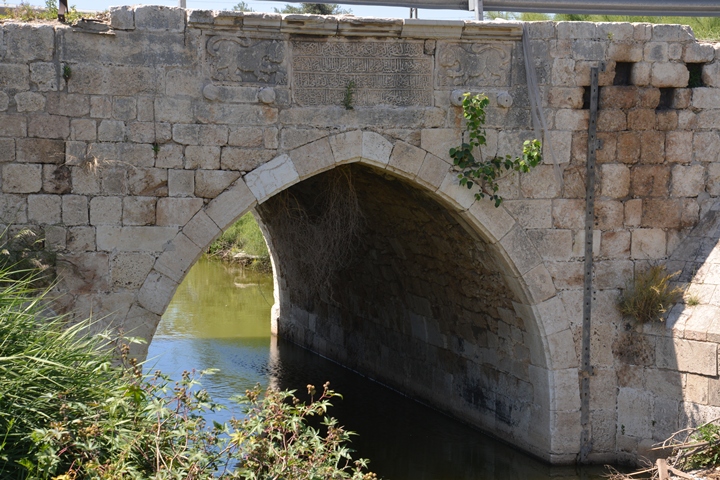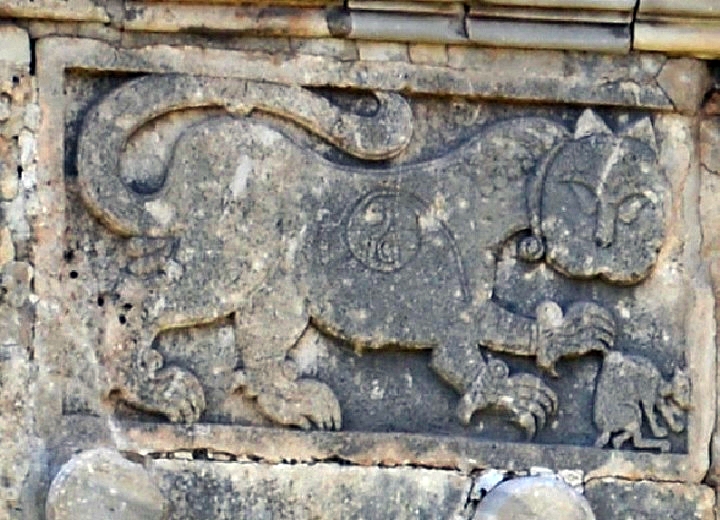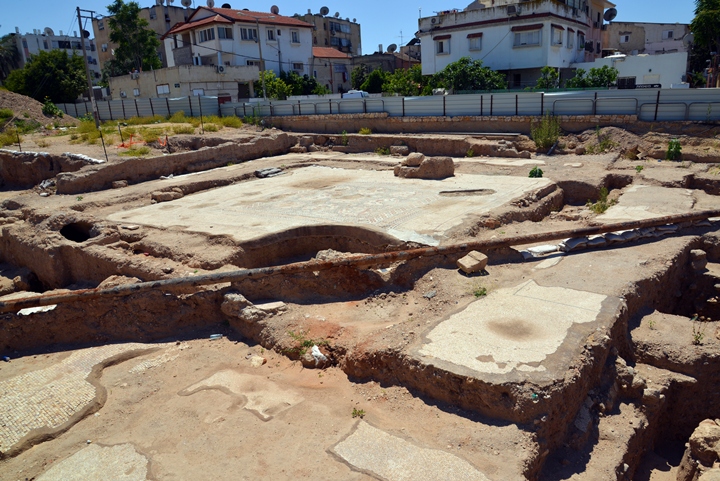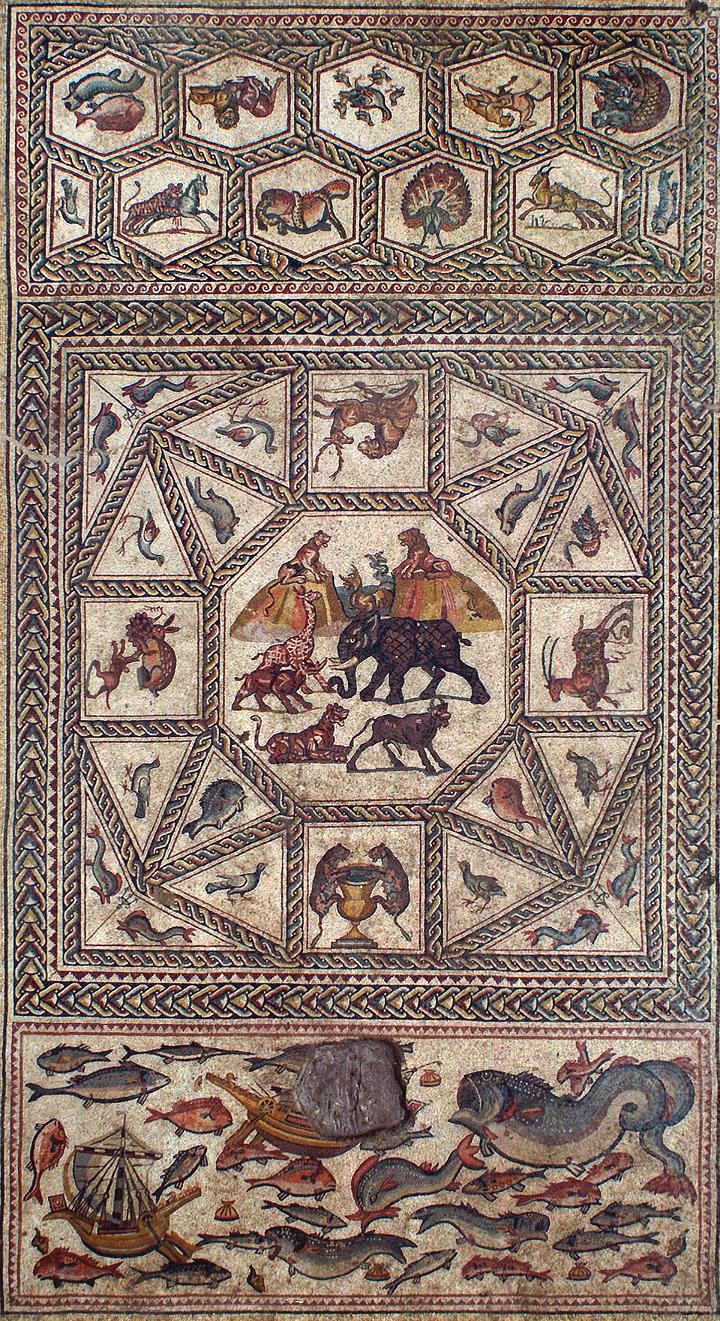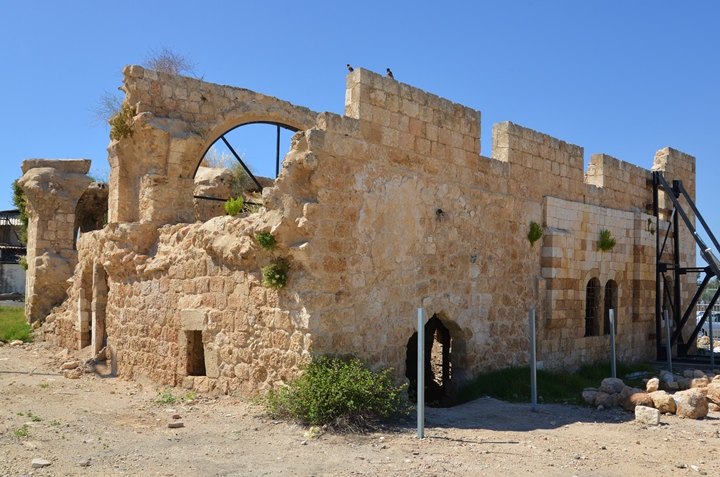Lod (Lydda) is a historic city, starting from a Canaanite city situated along two major roads in the heart of the Country. The birth and burial place of the famous St. George, an early Christian Martyr who inspired the Crusaders and Christian World.
Home > Sites > Shefela > Lod (Lydda) – Overview
Contents:
Background
Location
History
Photos
* Aerial
* St. George
* Mosque
* Khan el-Hilu
* Tel Lod
* Mameluke bridge
* Mosaic floor
* Soap Factory
Etymology
Links
Background:
Lod, historically known as Lydda, is an ancient city located in the Central District of Israel. It holds significant historical and cultural importance, dating back to Biblical times. The city is mentioned in the Old Testament as one of the cities conquered by the tribe of Ephraim.
One of the most famous stories associated with Lydda is the healing of Aeneas by the apostle Peter, as recorded in the New Testament. According to the Acts of the Apostles, Peter healed a paralyzed man named Aeneas in Lydda, which led to many people in the city converting to Christianity.
St. George, a Christian martyr, is one of the most venerated saints in Christianity. The association between St. George and Lydda has made the city an important pilgrimage site for Christians. The Church of St. George in Lod is believed to be built over the burial place of St. George, and it has been a place of veneration for centuries.
Throughout its history, Lydda has been inhabited by various civilizations, including the Greeks, Romans, Byzantines, Arabs, and Crusaders. It became a significant Christian center during the Byzantine period.
In the Middle Ages, the city was conquered by the Muslim Caliphate and later by the Crusaders. It was eventually incorporated into the Ottoman Empire and remained under Ottoman rule until the British Mandate period.
This page is an overview of the old sites of Lod. Additional information can be found in web pages that provide site specific information and photos.
Location:
The following aerial view shows some of the the points of interest on and around Lod.
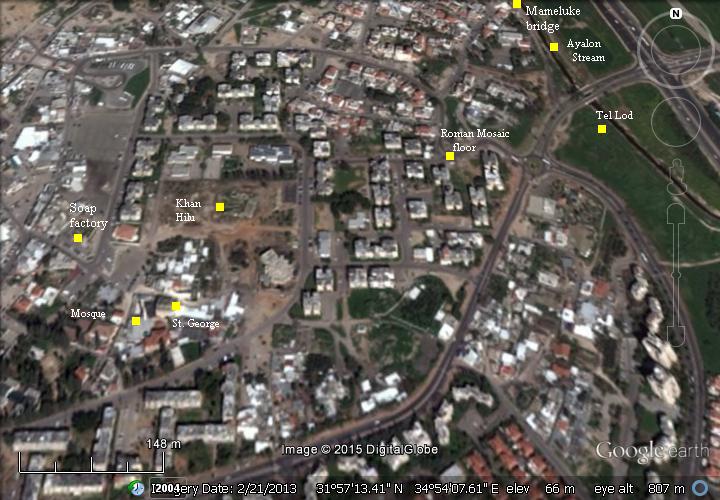
History:
-
Prehistory
Settlement in Tel Lod, an artificial mound in the north side of the city, on the south bank of Ayalon stream, started in the Epi-Paleolithic period (16,000-8,300 BC). Remains of this period as well as the Chalcolithic period (4,500-3,150 BC) and Early Bronze period (3,150-2,200 BC) were identified in the excavations.
-
Biblical times – Late Bronze period (1550-1200 BC) and Iron Age (1200-539 BC)
Scholars debate whether the Canaanite city was destroyed before or during the conquest of Canaan by the Israelites. According to the Bible, Lod was settled by the tribe of Benjamin (1 Chronicles 8: 1,12): “Now Benjamin begat…and Shamed, who built Ono, and Lod, with the towns thereof “.
This map, illustrating the greater area of the site, indicates the roads and sites during the Biblical period (Iron age period until the Roman period). Lod/Lydda is situated along two major roads – the west/east road from Jaffa/Joppa to Jerusalem, and the north-south coastal road (“Via Maris”). The city’s location was at the point of crossing of the Ayalon stream.
Map of the area around Lod (based on Bible Mapper 3.0)
-
Persian and Hellenistic periods (6th – 1st Centuries B.C.)
After the return from the Babylonian exile, Lod was resettled (Ezra 2:1, 33): “Now these are the children of the province that went up out of the captivity, of those which had been carried away, whom Nebuchadnezzar the king of Babylon had carried away unto Babylon, and came again unto Jerusalem and Judah, every one unto his city; … The children of Lod, Hadid, and Ono, seven hundred twenty and five”.
Lod/Lydda was a Jewish city, and was incorporated into the Hasmonean Kingdom in 147 BC as part of a treaty the Hasmonean King Jonathan managed to secure from the Seleucids (1 Maccabees 11:32-34): “King Demetrius to the Honorable Lasthenes, greetings. I have decided to grant the Jewish nation certain benefits because they are our loyal allies and keep their treaty obligations. I confirm their rights to the land of Judea and the three regions of Ephraim, Lydda, and Arimathea, which are hereby annexed to Judea from Samaria with all the lands belonging to them”.
-
Early Roman – (1st B.C. – 1st Century A.D.)
The Roman city of Lydda was located in the area of the ancient Tel Lod, and in the area north of it until the Lod bridge.
Simon Bar-Yonah, named by Jesus as Peter (“rock”), was one of the 12 apostles of Jesus. He is regarded as the most important and spokesman of the Apostles, and considered as the first Pope.
Peter leads the early Christian community after Jesus. He was imprisoned by King Herod, but the angle rescued him (Acts 12: 1,5,17). After his release, Peter then travels to here, and to other cities: Joppa (Jaffa), Caesarea (Maritama) and Antioch, on a missionary journey intended to convert gentiles.
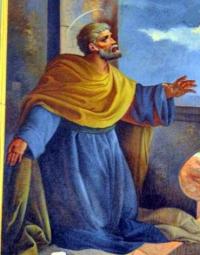
St . Peter in Jaffa/Joppa
His visit to Lod/Lydda is described in reference to the saints who dwelt here (Acts 9 32-34):
“And it came to pass, as Peter passed throughout all quarters, he came down also to the saints which dwelt at Lydda. And there he found a certain man named Aeneas, which had kept his bed eight years, and was sick of the palsy. And Peter said unto him, Aeneas, Jesus Christ maketh thee whole: arise, and make thy bed. And he arose immediately. And all that dwelt at Lydda and Saron saw him, and turned to the Lord.”
Great Revolt: During the first months of the great revolt against the Romans (66AD), the town was mentioned in the accounts of the Jewish general – turned Historian – Josephus Flavius. Cestius Gallus, Governor of the Roman province of Syria, came to smother the rebellion. Accompanied with a force of the 12th Legion, 6,000 soldiers from other Legions, and local forces opposing the rebellion, the Romans raided the country. They burnt the cities of Jaffa, Lydia and other towns. (Wars 2 19:1):
“But when Cestius had marched from Antipatris to Lydda, he found the city empty of its men, for the whole multitude were gone up to Jerusalem to the feast of tabernacles; yet did he destroy fifty of those that showed themselves, and burnt the city, and so marched forwards…”.
Titus Arch, Rome
– the victory procession of Titus, son of Vespasian (right, on chariot)
During a later phase of the revolt, both Lydda and Yavne surrendered to the Romans, and so the Roman General Vespasian allowed the Jews to return to those cities. Both cities became centers of Jewish scholars, places of Torah study, and schools.
The city enjoyed great prosperity from its Textile and Ceramic industries.
-
Late Roman period (2nd Century-4th Century AD)
In the year 201 AD Caesar Septimius Severus gave the city a status of a Roman Colonia, and renamed it Diospolis (“city of God”). Coins were minted in the city, with the Greek letters “Diocpolic”. A Roman military base was established in the city, with the purpose of keeping a watch on the significant Jewish presence in this area, and in order to protect this strategic crossroad.
St George was born and lived in the 3rd century AD in the city of Lod (Lydda). George, an early Christian, served as a Roman tribune and died in Asia Minor in 303. He is the most important soldier-saint in Christian tradition since the Byzantine period.
According to one of the legends, George was a victim of the last and most severe of persecutions of the Christians in the Roman empire. Diocletian ( Caesar 284-305) issued an edict in 303 AD, instructing that all Christians should be purged from the Roman Army. During the army’s roll call in the city he was stationed, Nikomedia, the edict was announced, and George – who until then secretly practiced Christian faith – tore up the letter. This revealed his secret, and the court sentenced him to a gruesome death: George was placed in a barrel, head down, and he drowned from the spit of the 6000 soldiers.
George is regarded as a martyr, a great Holy warrior saint, and is also illustrated in all Greek Orthodox Churches as the “dragon slayer”. The dragon slaying is based on a tradition, probably told during the Crusaders period, of an event that happened in Lebanon many years after the martyr’s death. According to this legend a princess was threatened by a dragon, and George appeared and with great heroism attacked and killed the dragon with a spike. In these illustrations, the princess is seen hiding in a fortress (see example on the right) and George spikes the dragon.
This church was dedicated to St George in the Byzantine times. A stone coffin is located in the crypt of the modern church, where according to the tradition his bones are located.
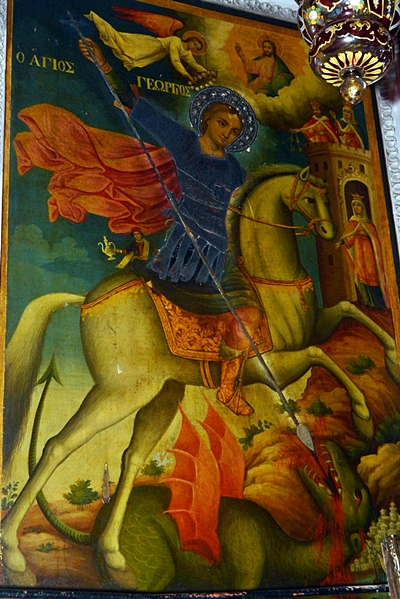
St. George killing the dragon (St. George, Lod)
The Jewish center of the city was burnt by the Roman legions during the Constantinus Gallus revolt (351/2 AD), as Lydda was one of the centers of this revolt. The Christians became the majority of the residents in the city.
-
Byzantine period (4th to 7th century A.D.)
In the Byzantine period the city witnessed a commercial prosperity, thanks to the Christian pilgrims who came to see the city where Peter cured the sick man, and the birth and resting place of St. George.
George was venerated (honored as a saint) at the end of the 5th century. During the 6th century, a large Church was built over the traditional site of his burial site. Remains of this church can be seen in sections of the adjacent mosque.
An ancient map of the Holy Land from the 6th century AD was discovered in 1884 in a Byzantine church in Madaba, Jordan. The map shows the the Holy Land, with dozens of illustrated sites.
Lod is illustrated with great details, implying its Christian importance. The Greek inscription above the icon reads “Lod (ΛωΔ) also Lydea (ΛΥΔΕΑ), called also Diospolis (ΔΙΟСΠΟΛΙС). The city is not walled according to this map.
A section of of the 6th Century Madaba map – Lod
The Byzantine church of St. George is shown as a large structure with a red roof. A semicircular roofed colonnaded plaza appears in front of the church. Three houses are adjacent to the south side of St. George.
Another roofed colonnaded east-west street appears to the north of the church. Adjacent to it is a second northern church, also illustrated as a a red roof with a cross. Near it is a white structure, or another colonnaded street.
The Sasanian-Persians defeated the Byzantines in the battle of Antioch (613) and conquered the land (614). They damaged the Church.
-
Arab period (7th – 11th century A.D.)
After the conquest of Jerusalem and the Holy Land by the Arabs (638AD), Lod became a regional government city and was renamed Lydda. In 716 the Umayyad Caliph Sulayman ibn Abu al-Malik founded a new city nearby, naming it Ramla. This moved the center of power to the new city, while Lod/Lydda was partially destroyed.
The church was initially unharmed, as it was honored by the new rulers, who respected St. George and his burial place, as well as other Christian sites. However, the Byzantine church was later leveled by the Arab rulers when their faith became more extreme. The church was destroyed, as suggested by scholars, in 1010 by the Fatimid ruler Al-Hakim bi-Amr Allah (985-1021). This ruler was known as the “Mad Caliph”, as he destroyed the Holy Sepulcher in Jerusalem (1009) and all the convents and churches of the Holy Land in the following years.
-
Crusaders (12th – 13th century A.D.)
The destruction of the Holy Sepulcher may have sparked the Crusades, which were aimed at regaining the control of the Holy city and rebuilding the Holy Sepulcher. The crusade to liberate the Holy Land and free Jerusalem was initiated in the great council meeting of Piacenza (March 1095), following an appeal from the Byzantine emperor Alexios I Komnenos to repel the Muslim (Seljuk) Turks conquests in the south Turkey. Pope Urban II (1042-1099) pushed for a military action to the Holy Lands at the council of Clermont (27 November 1095), with the primary goal to assist the Byzantine capitol of Constantinople. His speech at the council had a great influence, resulting in a call for arms throughout Europe to regain the Holy Lands under the name of God.
On June 3, 1099, three years after the military expedition started in Europe, the Crusaders finally approached the gates of Jerusalem, passing through Lod and camped 3 days in the nearby Arab city of Ramla. They butchered the Jewish residents of Lod.
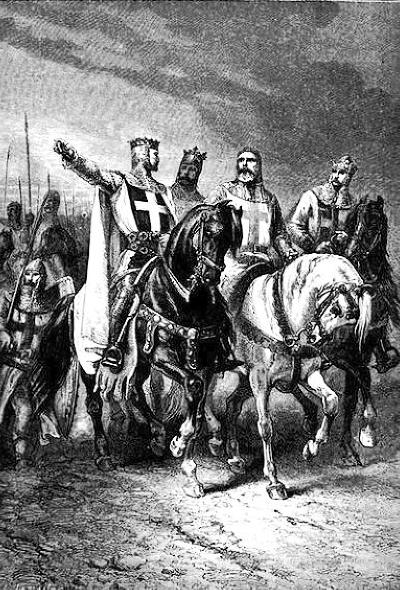
Leaders of the first Crusade – – by Gustav Dore (French artist, 1832-1883)
The PEF survey reported about this (Vol II, sheet XIII, p. 274): “The Crusaders in 1099 a.d., on their march from Antioch to Jerusalem, having celebrated the Day of Pentecost at Caesarea, directed their course to Lydda, where they found the splendid tomb and church of St. George. Count Robert of Flanders, with five hundred knights, was sent forward to reconnoitre the neighbouring Ramleh, and found the gates open and the city deserted of inhabitants. The host of Crusaders followed, and took up their quarters in Ramleh for three days, recruiting themselves with the abundance of provisions which the inhabitants had left behind in their flight. Here they celebrated a festival to St. George, who had already aided them in the battle near Antioch, and with due formality installed him as their patron saint. His tomb at Lydda was made the scat of the first Latin bishopric in Palestine; and Robert, a priest from Rouen in Normandy, was on the spot appointed bishop, and received tithes from the pilgrims. The new see was endowed with the cities of Ramleh and Lydda and the lands belonging to them. On the fourth day the army proceeded towards Jerusalem”.
Jerusalem was captured finally a month later, thus completing the First Crusade goal and establishing the Kingdom of Jerusalem.
The Crusaders rebuilt the Church in years 1150-1170, fortifying it in order to protect the road to Jerusalem. They renamed it St. Jorge de Lidde. The location of the Crusader church were above the ruins of the Byzantine church. Remains of the Crusader structure can be seen in the 19th Century church and in the adjacent mosque, which reused some of the Crusader structure.
Ayyubid conquest: The Ayyubid dynasty was founded by Saladin (Salah ad-Dīn Yusuf ibn Ayyub), and ruled Syria and Egypt (1171-1341). They defeated the Crusaders in the decisive battle of Hittim (July 4, 1187). Following this victory, most of the Holy Land – including Lod – were captured by Saladin 1187. The church was destroyed by Saladin’s armies in 1191.
A third Crusade, headed by Richard the Lionheart, recaptured the coast line including Lod (1192). St. George became a popular “warrior” saint for the third Crusade. According to legends, the warrior saint helped the Crusaders in their battles.
After the Crusaders returned back to Europe, the soldier-saint became popular in many countries in Europe. Richard adapted the emblem of the Cross of St. George – a red cross on white background – and brought this symbol back to England. During the 13th Century the cross of St. George became the national flag of England, and in the late 14th Century St. George became England’s patron saint. About 200 English medieval churches were dedicated to St. George.
Flag of England – St. George emblem
A peace treaty of 1198 gave the Crusaders the right to hold the coast line cities. The Crusaders held this region until 1263.
-
Mamelukes – (1263-1516 A.D.)
The Mamelukes were Turkish prisoners of the Mongols who were sold to the Sultan of Egypt, trained by him and served as his palace guards. In 1250 the Mamlukes, headed by Bybars, seized the control of Egypt, and defeated the Mongols (1260) and captured the Holy Land (1263).
Lod was an important Mameluke city, situated on the road to Jerusalem. They constructed an impressive bridge and great mosque:
-
Mosque: In 1268 the Mamelukes built a mosque on the ruins of the Church. It was named El-Omari, as other mosques that were built on top of ruined Churches. Omari (Omar Ibn El-Khattab) was the conqueror of the Holy Land in 638 AD.
-
Bridge: In 1273 the Mamelukes constructed a bridge over the Ayalon stream near the city of Lod. The impressive bridge (“Jisr Jinda”) is 30m long, 13m wide, and is supported by three arches. On both sides of the bridge is an inscription commemorating Baybars and the builder, with an illustration of a cheetah (royal symbol of Bybars, often misplaced with a Lion). It appears toying with a rat, symbolizing their enemies. The construction of both mosque and bridge were managed by Ala e-Din a-Suk.
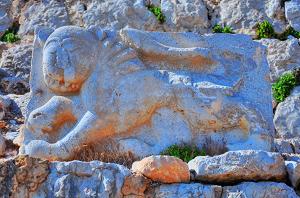
Symbol of the first Mameluke Sultan Bybars – Nimrod –
another Mameluke fortress on the northern Golan road
An old photo of the Mameluke bridge is seen here:
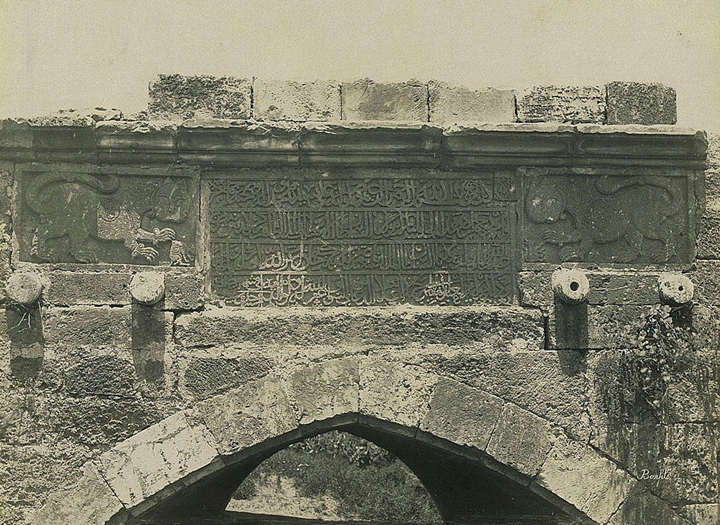
Library of Congress – photo be Maison Bonfils (taken in dates 1867-1899)
The Mamelukes continued to rule the entire region until 1516, when they were defeated by the Ottomans from Turkey.
-
Ottoman Period – (1516-1918 A.D.)
The famous painter of the Holy Land, David Roberts, visited Lod in march 29, 1839 and illustrated this beautiful view of the city.
The area of was examined in the Palestine Exploration Foundation (PEF) survey (1866-1877) by Wilson, Conder and Kitchener. The map below is a section of their survey results. The sites of Lod are described in their report (Vol 2, Sheet XIII, p 252):
“Ludd – A small town, standing among enclosures of prickly pear, and having fine olive groves round it, especially to the south. The minaret of the mosque is a very conspicuous object over the whole of the plain. The inhabitants are principally Moslem, though the place is the seat of a Greek bishop resident in Jerusalem. The Crusading church has lately been restored, and is used by the Greeks. Wells are found in the gardens. Ludd is the Old Testament Lod, the New Testament Lydda. The church appears to date about 1150 A.D. The mosque and minaret are noticed by Mejr ed Din, 1495 A.D. The houses are principally of mud. There Is a palm-tree near the church, and figs are also cultivated”.
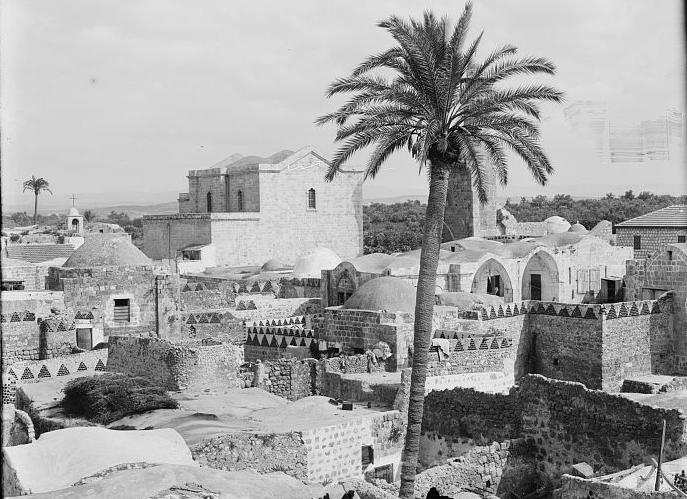
Lydda and the church of St. George
Library of Congress – American Colony – photo 1900-1920
The sites of Lod (Ludd) are detailed in other sections of their report (p. 268) –
“Ludd – The fine Crusading church of St. George, with the small side church of St. James, have been partly rebuilt. The nave and north aisle of the former are now made into a Greek church, two bays of columns being restored. The whole length was originally six bays, but the remainder is now used as the court of a mosque. The south aisle is destroyed, but the base of one column is still visible. This aisle measured 21 feet 7 inches across, and the nave 36 feet, giving a total of 79 feet. The total length is about 150 feet. The southern chapel of St. James is now a mosque. It was planned by M. le Comte for M. Clermont Ganneau in 1874. The true bearing of the church is 90°. The church dates from about 1150 a.d. and contains a crypt where the tomb of St. George is shown. The diagonal dressing is very marked on the bases of the pilasters. Visited January 18th, 1874”.
The PEF report also described the history of St. George (p. 268):
“According to ancient tradition, St. George was born at Lydda ; he suffered martyrdom at Nicomedia, and his remains were carried to his native town, where his head still rests beneath the altar of the great church consecrated to him. Several of the early pilgrims speak of Lydda as the place where St. George is buried. Bernard speaks of the “Monastery of St. George” as near Ramleh. Now there was a monastery of St. George at Lydda itself, and where there was a monastery there would be a church. It is therefore most probable that the tradition is true which represents a church to have been built on this spot in very early ages. It is said to have been destroyed by Hakem in the year 1010, rebuilt by King Stephen of Hungary, destroyed again by the Mahommedans at the invasion of the Crusaders, and rebuilt by them with much magnificence. It seems to have been finally destroyed, until its partial restoration in late years, by Saladin ; the story that it was rebuilt by Richard being impossible. In the year 1863 the discovery of a tomb was made here. It is reported by M. Guerin, and seems never to have been followed up: ‘I have heard that, a month before my arrival, a peasant had made an interesting discovery in a field quite close to the town. While digging an excavation for some purpose he brought to light the entrance of a souterrain enclosing two sepulchral chambers, which contained some thirty small coffins, whose length was not more than 2 feet 3 inches. They were each covered with a slab, and were still full of bones, but not one head was found among them. In the midst of one of these chambers was found a large stone sarcophagus 6 feet 6 inches long, and broad in proportion, in which lay a skeleton, not broken but at full length, and also without the head. On the front face of the sarcophagus was engraved a cross with equal branches, accompanying a Latin inscription.’
The place had been closed by order of the authorities, and Guerin could not effect an entrance. It would be interesting to make a further examination of this tomb with its headless occupants”.
Part of map sheet 13 of Survey of Western Palestine,
by Conder and Kitchener, 1872-1877.
(Published 1880, reprinted by LifeintheHolyLand.com)
A detail of the center of Lod is shown here:
-
Modern times
Today, Lod is a modern city with a diverse population and serves as an important transportation hub due to its proximity to Ben Gurion International Airport and major highways. It’s also known for its archaeological sites, including remnants of its ancient past, which attract tourists and scholars interested in its rich history.
The center of the old city is mostly ruined, with few old structures standing today. However, it is recommended to tour the old city and visit those structures that remain, such as St. George.
Photos:
(a) City center
Most of the old city of Lod is gone, and only few remains can be seen among modern buildings.
An aerial view, captured by a quad copter, shows the area of St. George from the north side. The Church and Monastery are located to the left side of the minaret of its adjacent mosque.
Click on the photos to view in higher resolution…
(b) St. George:
St. George, the most important soldier-saint in the Christian tradition, was born in Lod (Lydda). The church was first constructed in the Byzantine period, rebuilt by the Crusaders, and rebuilt during the late Ottoman period.
Steps on both sides of the main hall leads to an underground chamber – the crypt of the church – where the bones of St. George are buried. The crypt is dated to the Byzantine period, and the Crusaders and Ottoman period churches were actually built over it.
![]() For more info on St. George, click here.
For more info on St. George, click here.
(c) Grand Mosque and El-Omari Mosque:
The Grand mosque (Jamaa el-Kebir) is adjacent to St. George, and built over a section of the Church on its west side. Its high minaret tower is seen in this photo, as well as the courtyard. The structure on the left corner is a place where the body is washed prior to former prayers and reading the Quran (the Islamic Wudu procedure).
Sections of the Byzantine and Crusaders structures are embedded inside the mosque.
Behind the Grand mosque, on the south side, is the el-Omari Mosque. It was built in 1268 during the Mameluke period, and is named after Omar Ibn el-Khattab (577-644), the Caliph who conquered Jerusalem in 637 AD and expanded the Islam Caliphate.
(d) Khan el-Hilu:
An impressive 19th Century Khan (inn, caravansary) located near St. George. Excavations and conservation works are reconstructing this unique structure, with plans to open it as a major tourist attraction.
An aerial view, captured by a quad copter, shows the Khan from the west side. The entrance to the site is from a gate on the lower side of the picture.
![]() For more info on Khan el-Hilu, click here.
For more info on Khan el-Hilu, click here.
(e) Tel Lod:
Tel Lod, the ancient Canaanite and Israelite period city, was located on an artificial mound in the north side of the city, on the south bank of Ayalon stream. Remains of the ancient periods were identified in the archaeological excavations. These ruins are not visible today above the surface.
(f) Mameluke Bridge:
In 1273 the Mamelukes constructed a bridge over the Ayalon stream near the city of Lod. The impressive bridge (“Jisr Jinda”) is 30m long, 13m wide, and is supported by three arches.
On both sides of the bridge is an inscription commemorating Baybars and the builder. The construction of both mosque and bridge were managed by Ala e-Din a-Suk.
On both sides of the inscription is an illustration of a cheetah (royal symbol of Bybars, often misplaced with a Lion). It appears toying with a rat, symbolizing their enemies.
(g) Mosaic floor:
In 1996 an impressive 4th Century AD mosaic floor was found in Lod, located near the Ayalon river on the north east side of the old city (along He-Khaltuz street). The purpose of the structure, in which the floor was laid out, is yet unknown.
The 18 square meter floor, the largest found in Israel, and is “composed of colored carpets that depict in detail mammals, birds, fish, a variety of flora and the sailing and merchant ships that were used at the time” (- IAA report, from excavations directed by M. Avissar).
Photo courtesy of the IAA
The site is part of a new Archaeological museum, which was opened in June 2022.
![]() Watch a video of the mosaic:
Watch a video of the mosaic:
(g) Soap Factory:
Al-Far soap factory is an early 19th Century stone structure located near the great mosque. The soap was made by crushing olives, then cooked with ash from plants and other oils and chemicals. After the soap bars were left to dry, they were cut, wrapped and packed in boxes.
The structure is not yet open to the public, but is planned to join the other historic gems of Lod to be part of a large Archeological center.
Etymology (behind the name):
* Names of Lod:
- Lod – Hebrew name (1 Chronicles 8: 1,12): “Now Benjamin begat… and Lod, with the towns thereof “.
- Lydda – Hellenistic and Roman name
- Diospolis – Name of the city after Septimius Severus elevated the status of the town in 200AD
- al-Ludd – Arabic name
Links and References:
* Archaeology and History:
- Ancient Lod community archaeology Youtube
- Ancient Lod community archaeological project
- Tagliot – “Archaeology for All” (Hebrew site) – arranged the tour, which was guided by guided by Dr. Yigal Sitry, director of the Ramla museum.
- Mosaic floor [IAA report]
- Lod Mosaic floor home page
- Lod Mosaic inaugurated
* Lod sites:
* Internal links:
- Quadcopter Aerial views – collection of Biblical sites from the air
BibleWalks.com – tour the Land with a Bible in the hand
Khan el-Hilu <<–previous site—<<< All Sites>>>—next Shefela site—>>> Arches Pool
This page was last updated on Oct 3 (add link)
Sponsored links:
